How community aid gets from SoCal to Maui’s wildfire survivors
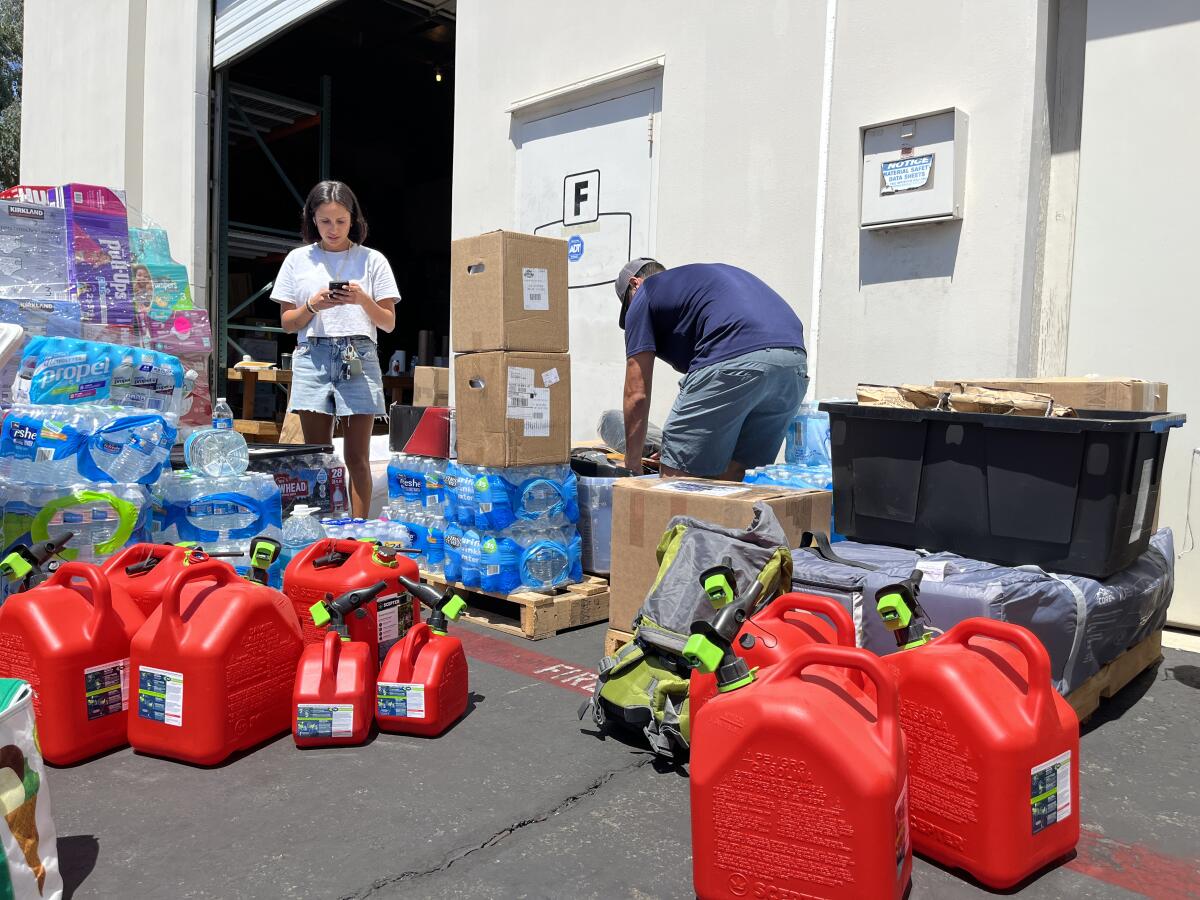
Good morning, and welcome to the Essential California newsletter. It’s Friday, Aug. 18.
When I hopped on the phone with Kati Kai Engle late Monday evening, she giggled.
“I feel like tonight I’ve hit a level of exhaustion that makes everything funny,” she said. Engle had been up since dawn that day coordinating volunteer and donation efforts for wildfire victims in Maui.
In the aftermath of what is now the deadliest American wildfire in a century, thousands of people on the mainland are eager to help. They’re collecting supplies, they’re rallying their communities and they’re looking to people like Engle to help distribute those donations.
But Engle’s role is a unique and challenging one, from sorting out the logistics of transporting donations to ensuring that fire survivors’ needs don’t get lost in the process.
That’s part of why her group, Community Relief Maui, announced it would stop collecting donations on Thursday, citing difficulties with managing the volume of donations and concerns about contributing to waste on Maui. The announcement came after ups, downs and lots of full pallets, a process she shared with me this week.
Engle grew up in Lahaina, and she’s familiar with the devastation of wildfire season. Her family had to evacuate multiple times when she was in high school in the 2000s. “I grabbed my horses and got into my dad’s truck, drove through fences, through the fields, literally running from the fire at our backs,” Engle said.
The same intergenerational families who just rebuilt their houses from fires before now have their homes destroyed again, she said. The death toll has risen above 100, with 1,000 still missing.
Last week, Engle teamed up with Jennifer Lawrence, a friend who grew up in Central Maui, to send help back to their home. The pair were motivated by a saying they learned growing up: “Don’t forget about your backyard.”
As an independent clothing designer now based in San Juan Capistrano, Engle was familiar with how to get logistics running. She and Lawrence drew upon a community of friends and volunteers to help manage the donations in Southern California and keep an eye for needs on the ground.
On social media, they set up an Instagram account and designated three donation sites in Culver City, Costa Mesa and San Clemente during the August 12th weekend. Within seventy-two hours, they had hundreds of volunteers show up with boxes upon boxes of donations.
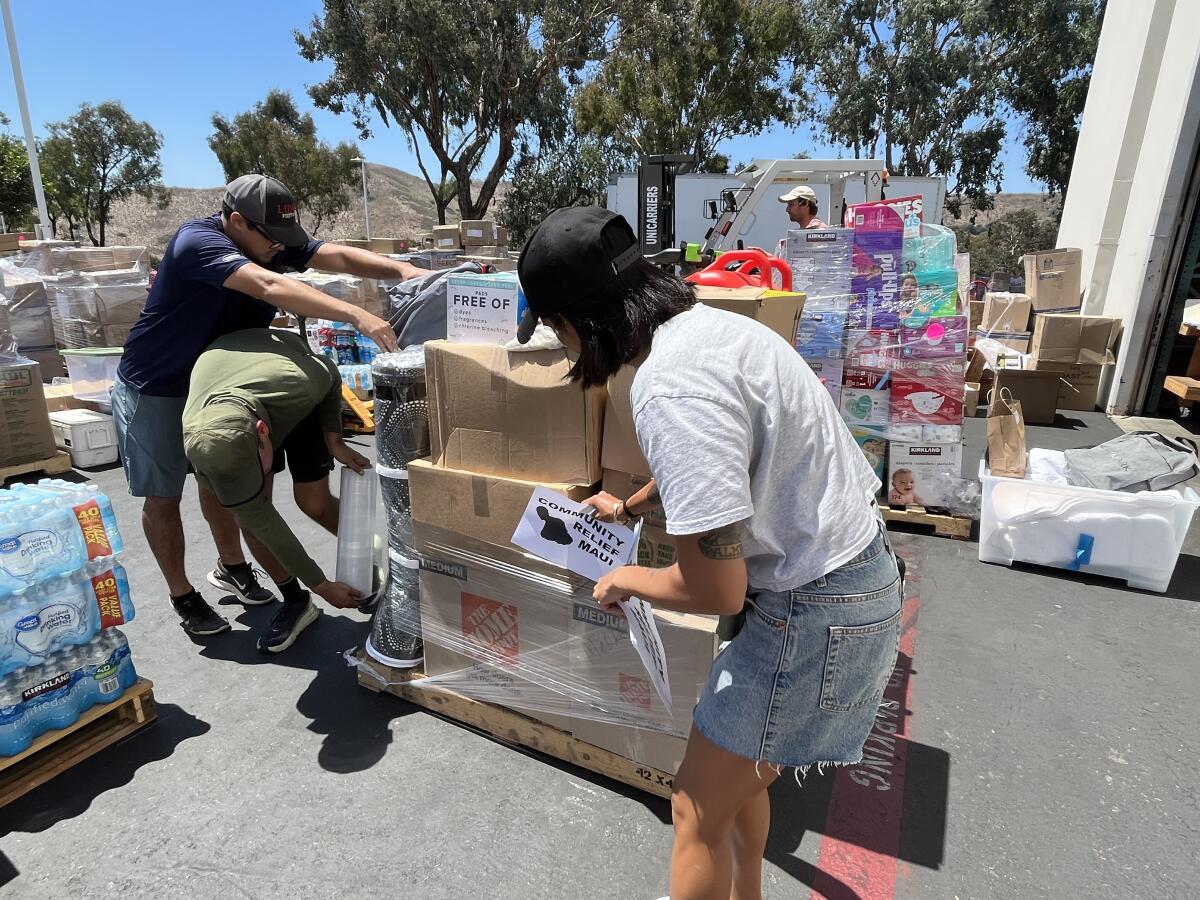
Packaging for the air and seas
When I visited their San Clemente warehouse on Wednesday, the first thing I noticed was rows and rows of pallets. Most, but not all, of the contents were about to begin a long journey to Maui.
Each day, Engle received a flood of text messages from friends on the ground, relaying and updating the survivors’ changing needs. Teams of volunteers built up different pallets based on the reports.
The team’s partner, H2O logistics, offered weekly sailings to Maui on their freight boats to the island. Because shipping by sea takes seven to 10 days, volunteers concentrated on sending urgently needed items, such as hygiene supplies, baby formula, diapers, water and tents.
Engle also added a few backpacks to some of the boxes. “[People] don’t have anywhere to put their stuff. They’ve lost their homes.”
Different pallets needed to comply with different standards, too. Lake Casco, an engineer based in Irvine and one of Engle’s high school classmates from Maui, was measuring pallets Wednesday to ensure they could fly. To go via air, a pallet had to be no more than 56 inches tall. The team also had to remove the batteries from flashlights to follow regulations.
A lot of this is last-minute coordination. Engle said she received a call at 3 p.m. on Monday from a private jet operator with room for cargo. With a few hours to spare, she posted a call out for truck drivers to Instagram. Within an hour, someone had volunteered to get the shipment to the airport.
When supplies hits the ground
On Wednesday, the first batch of parcels from the Community Relief Maui team landed via a private jet on Maui. Dave Horseman was there to receive the packages and help them begin the next step of their journey.
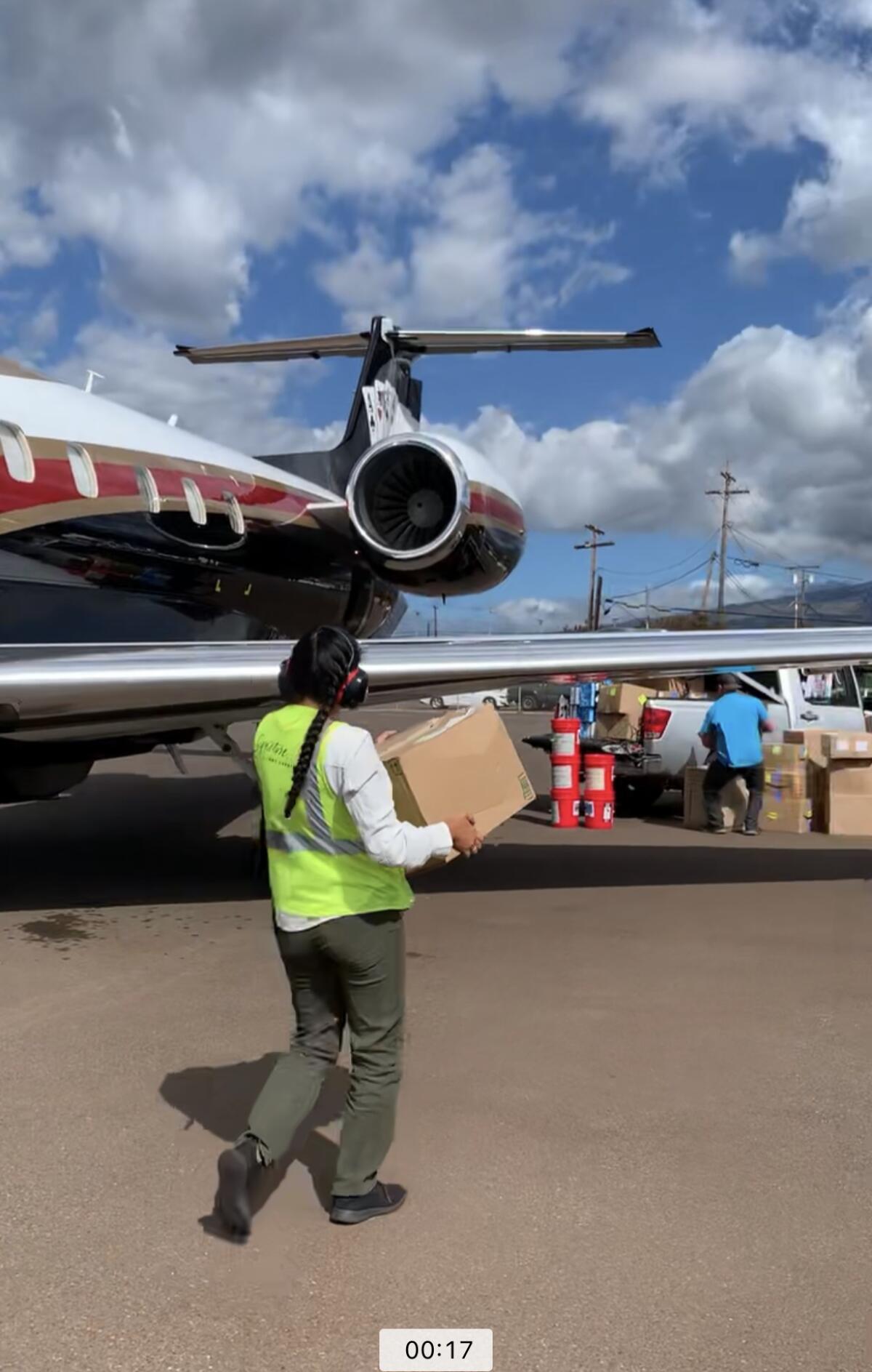
He would send some packages to a distribution center near Olowalu and others to Kahana boat ramp, a regular gathering place for families that has now been converted to a recovery shelter.
“What everybody needs has changed like three or four times,” Horseman said.
While the community is working to rebuild more permanent shelters on the island, Horseman said, generators had moved to the top of the list by the middle of the week. Thankfully, the San Clemente warehouse had just received one.
Medicine and masks were also in high demand due to the toxins in the air, said Matty Schweitzer, another local relaying information to Engle who is working with camps on the ground. Earlier this week, he facilitated a shipment of insulin from Los Angeles.
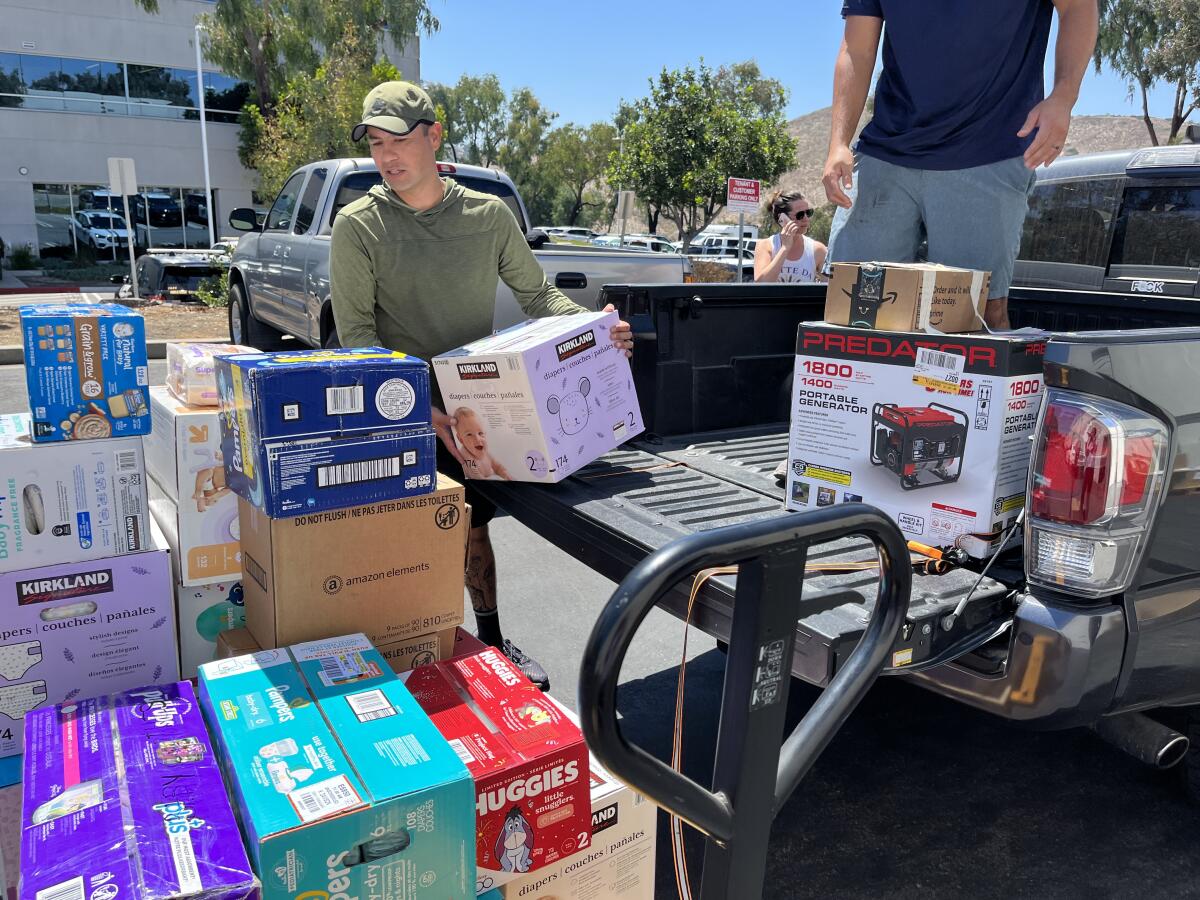
Matching donations and recipients is the more challenging task for groups like Community Relief Maui. It often involves saying no to people who want to help, Engle said.
“We are being conscious of not putting a strain on any of their resources,” Engle said.
On Monday, the team donated a truckload of used clothing to Goodwill. Clothes require too much time and too many resources to process, and that’s even when the items are practical: one volunteer said he saw a pair of stilettos and a fur coat.
Although it’s easy to feel helpless during disasters, Engle hopes that people think with intention before they donate.
“One of the most important keys right now is staying reactionary to immediate needs,” Engle said. “Hang tight and don’t get discouraged. Maybe they can’t help right now, but down the line we’ll need it just as much. This is a marathon, not a sprint.”
And now, here’s what’s happening across California:
Note: Some of the sites we link to may limit the number of stories you can access without subscribing.
L.A. STORIES
Although the fires have changed Maui’s landscape, a restaurant in Los Angeles preserves a snippet in time. At Back Home in Lahaina in Carson, walls are decorated to look like Lahaina landmarks. In the midst of tragedy, the restaurant has become a place to mourn and celebrate over live music and good food among diners who have friends and relatives back in Hawaii. Los Angeles Times
Radiotron, a hip-hop dance club, became a safe haven for Angeleno youth. For years in a building across the street from MacArthur Park, kids would get on stage and practice their footwork. It was a place where they could fully express themselves and stay away from drugs and gangs. Aaricka Washington explores the history of Radiotron and how it launched the careers of many dancers and artists in West Coast hip-hop. LAist
JUSTICE AND POLICING
California police body camera footage can’t replace witness testimony. When a woman refused to testify against a man accused of assaulting her, a Los Angeles County judge used recordings of her accusations from a police officer’s body camera. This week, the California Supreme Court unanimously ruled that the use of the footage denied the accused man due process. CalMatters
Wag Hotels serve dogs and cats from Silicon Valley to Hollywood. But under what conditions? More than a dozen clients recently found their pets neglected and in danger, some with serious injuries and reeking of urine and feces. Current and former employees also say they were hired despite little to no experience in animal care and worked in dirty and understaffed facilities. San Francisco Chronicle
Support our journalism
HEALTH AND THE ENVIRONMENT
Researchers just released the most complete picture yet of California’s first human-driven ecological catastrophe. Saber-tooth cats, western horses and giant sloths used to roam Southern California. Then they disappeared. Using radiocarbon dating on remains from the La Brea Tar Pits, scientists have concluded that the magnificent mammals of the Ice Age vanished with shocking speed when a period of warm, dry climate conditions coincided with the arrival of humans and fire. Los Angeles Times
It’s hurricane season this weekend in California. Hurricane Hilary is rapidly intensifying off of Mexico’s west coast. While the storm could change course and downgrade as it hits land, forecasters predict the first rains could reach Southern California’s mountains and high deserts by Saturday afternoon. Los Angeles Times
CALIFORNIA CULTURE
Inside the collapse of the Pac-12. After 2024, the Pac-12 (now the Pac-4) may be no more. J. Brady McCollough takes us through the negotiations that took place and four surprising moments that crushed the conference. Los Angeles Times
Idled by the strike, screenwriters and actors compete on the softball field. Six teams in the Writer’s Guild of America Strike Softball League began playing games in July. After long days of pickets, actors, showrunners, stunt people and others are letting out their frustrations against Hollywood on the field. Los Angeles Times
Free online games
Get our free daily crossword puzzle, sudoku, word search and arcade games in our new game center at latimes.com/games.
AND FINALLY
Today’s California landmark is from Chris Long of Studio City: The Avenue of the Giants.
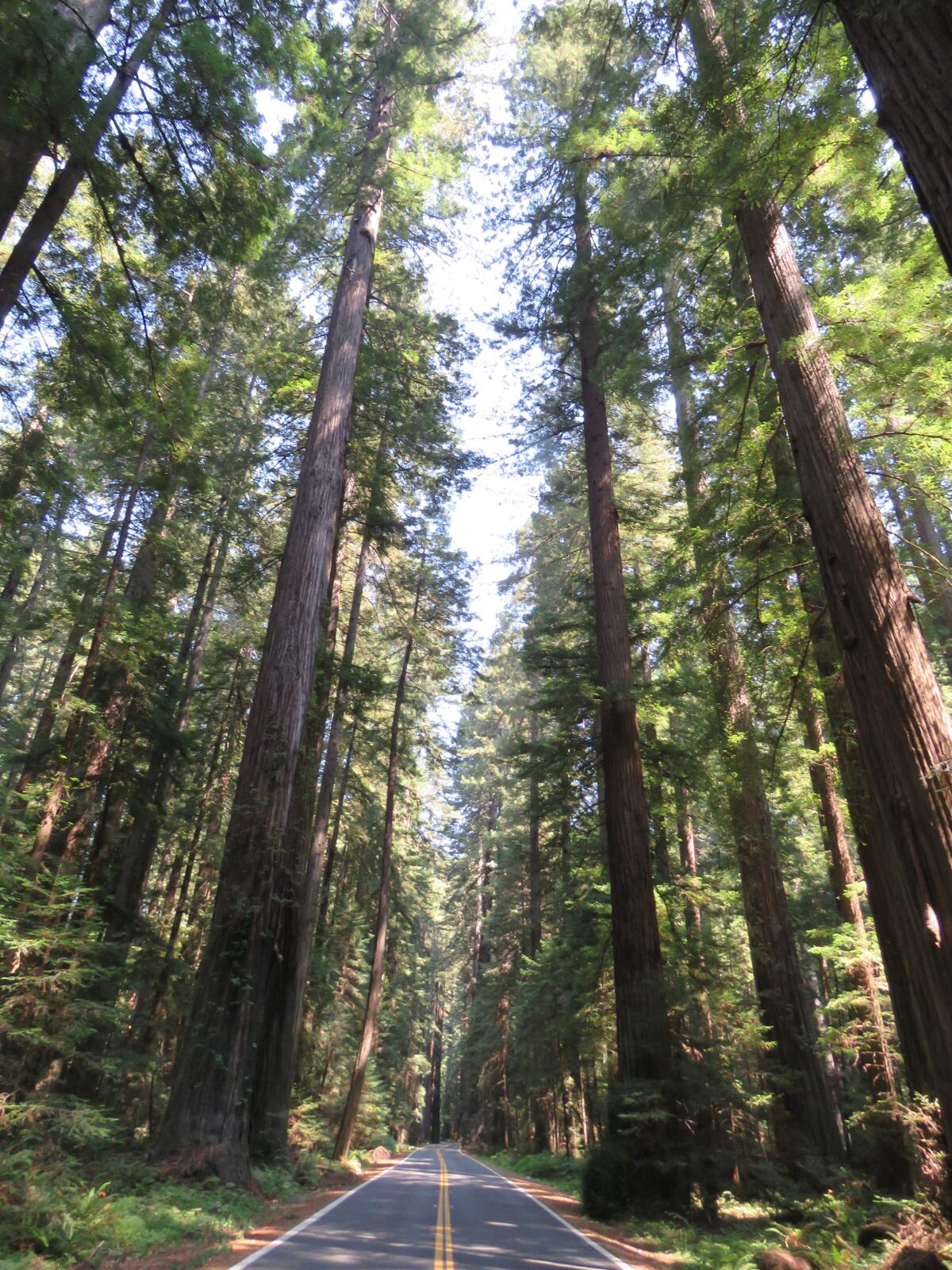
Chris writes:
The Avenue of the Giants is a 31-mile scenic road running through Humboldt Redwoods State Park in Humboldt County. There are numerous trailheads along the route, which connects with US 101 at the south and north ends.
What are California’s essential landmarks? Fill out this form to send us your photos of a special spot in California — natural or human-made. Tell us why it’s interesting and what makes it a symbol of life in the Golden State. Please be sure to include only photos taken directly by you. Your submission could be featured in a future edition of the newsletter.
Please let us know what we can do to make this newsletter more useful to you. Send comments to [email protected].
Sign up for Essential California
The most important California stories and recommendations in your inbox every morning.
You may occasionally receive promotional content from the Los Angeles Times.




